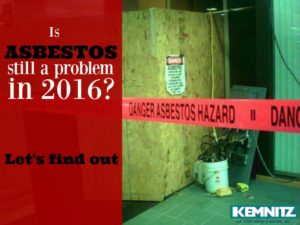Asbestos was a very popular building material for a long time. This composite of 6 naturally occurring silicate minerals gained popularity due to its desirable physical properties which made it the perfect material for building insulation, sound absorption and fire resistance among other uses. The use of asbestos continued to intensify through the 20th century until public knowledge, thanks to legislation and the courts, of the health risks of this mineral outlawed its use in mainstream construction and fireproofing in many countries across the globe. What were the issues and are they still relevant in the 21st century?
The Health Risks of Asbestos
Towards the last quarter of the 20th century, scientists realized that prolonged exposure to asbestos fibers was leading to serious and fatal illnesses including mesothelioma, asbestosis, asbestos warts, pleural plaques, Pneumothorax, diffuse pleural thickening and lung cancer. Symptoms that have been associated with asbestos exposure include: shortness of breath, hoarseness or wheezing, pain in the chest, fatigue, swelling of the neck among others. One who develops such symptoms is always advised to consult a doctor. Exposure to asbestos can come in many forms including: having asbestos as a component in your building materials, working with asbestos or materials that can lead to release of asbestos fibers or just handling asbestos in the process of getting rid of it from a site.
The nature of asbestos related diseases complicated asbestos litigation. The major challenge was the slow emergence of symptoms long after exposure to asbestos ceased. Remember that this mineral was widely acclaimed as a solution to all the construction issues earlier mentioned.
Thus attempts to outlaw its use faced stiff opposition from numerous quotas. This made the litigation process long and expensive but finally the mineral was out awed in many countries and remains so till now.
However, there are those who feel that outright ban of asbestos in not the solution. They contend that seeking innovative ways to prevent the lethal effects is a more realistic approach to the challenge. They argue that the benefits of asbestos are too important to wish away.
Has anything changed in the 21st Century?
It appears the only thing that has changed is time. There is no documented research that powerfully counters the facts about the dangers of asbestos as identified in the previous century. Neither have we evolved to develop resistance or immunity to the hazards of this mineral. Happenings in this century strongly support the idea that asbestos is still as dangerous to human health as it was in bygone eras.
Many governments have stringent regulation on the removal and disposal of asbestos. These are meant to protect all the people who are exposed to this mineral as well as protecting the environment in the process of disposing the asbestos. In addition the continued development of substitutes for asbestos in construction is a powerful admission that the mineral still carries its negative attributes in the 21st century. Fiber glass insulation, mineral wool and glass wool are perfect examples of these substitutes.
If you have ANY concerns about the air quality in your home, the experts at Kemnitz can help! Contact us today.
Category: General, Indoor Air Quality Tags: Asbestos, Asbestos Health Problems, Dangers of Asbestos, IAQ, indoor air quality, Old House Issues


